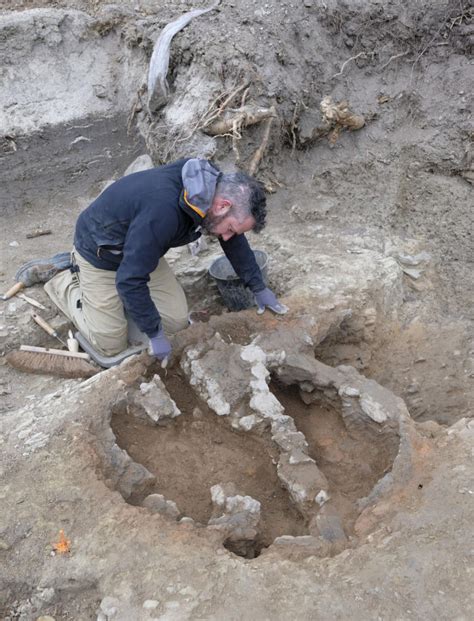
A tourist visiting Thailand’s ancient Wat Ratchaburana temple in Ayutthaya reportedly jumped into an 18-foot-deep pit, damaging several priceless statues and prompting a police investigation.
A foreign tourist caused significant damage to ancient artifacts at the Wat Ratchaburana temple in Ayutthaya, Thailand, after leaping into an approximately 18-foot-deep pit within the temple grounds. The incident, which occurred recently, has sparked outrage among local authorities and cultural preservationists, leading to a police investigation into the circumstances surrounding the event and the extent of the damage. The man, whose nationality has not yet been officially released, allegedly entered the restricted area and jumped into the pit, resulting in the destruction of several irreplaceable statues.
The Wat Ratchaburana temple, a historically significant site dating back to the 15th century, is a major tourist attraction and a protected historical landmark. The temple’s intricate architecture and the artifacts it houses are considered national treasures, making this act of vandalism particularly egregious. According to reports, the tourist bypassed warning signs and barriers before entering the pit.
“We are deeply saddened and angered by this senseless act of vandalism,” stated a representative from the Ayutthaya Historical Park, where the temple is located. “The Wat Ratchaburana is a sacred place and a vital part of our cultural heritage. We will do everything in our power to ensure that the person responsible is held accountable.”
Following the incident, local police were immediately notified and launched an investigation to determine the motives behind the tourist’s actions and to assess the full extent of the damage. Forensic teams were dispatched to the site to gather evidence and document the damage to the statues. The tourist was apprehended and is currently being questioned by police.
The incident has triggered a broader discussion about the need for increased security measures at historical sites across Thailand, as well as the importance of educating tourists about respecting local customs and preserving cultural heritage.
Wat Ratchaburana is one of Ayutthaya’s most impressive temples. Built in 1424 by King Borommarachathirat II, it commemorates his two elder brothers who fought to the death in a succession dispute for the throne. The temple is particularly known for its large prang (Khmer-style tower) and the crypt, which once held significant treasures and artifacts. Many of these treasures were looted in the past, but some remain and are of immense historical value.
The incident has highlighted the vulnerabilities of such historical sites and the challenges in protecting them from damage and vandalism. Local authorities are now reviewing security protocols and considering implementing stricter measures, such as increased surveillance, more prominent warning signs, and additional barriers to prevent unauthorized access to sensitive areas.
In addition to the criminal investigation, cultural heritage experts are assessing the damage to the statues and developing a plan for their restoration. The restoration process is expected to be complex and costly, requiring specialized skills and materials to ensure the artifacts are preserved for future generations.
The incident has also sparked a wave of condemnation from the public, with many expressing their outrage on social media and calling for the perpetrator to face severe consequences. The incident serves as a stark reminder of the importance of respecting cultural heritage and the need for greater awareness among tourists about the significance of preserving historical sites.
The incident at Wat Ratchaburana is not an isolated case. Similar incidents of vandalism and damage to historical sites have occurred in other parts of the world, highlighting the global challenge of protecting cultural heritage from both intentional and unintentional harm. These incidents underscore the need for a multi-faceted approach that includes stricter security measures, increased public awareness, and greater collaboration between local authorities, cultural heritage organizations, and the tourism industry.
Thailand relies heavily on tourism, and its historical sites are a major draw for visitors from around the world. The preservation of these sites is not only essential for maintaining the country’s cultural identity but also for ensuring the long-term sustainability of its tourism industry.
The investigation is ongoing, and authorities are expected to release further details about the incident in the coming days. The focus remains on determining the full extent of the damage, holding the responsible party accountable, and implementing measures to prevent similar incidents from occurring in the future. The incident serves as a critical reminder of the importance of respecting cultural heritage and the need for greater vigilance in protecting these invaluable sites for future generations.
Further details that may emerge during the investigation include the specific charges that the tourist may face, the estimated cost of the damage, and any mitigating factors that may be considered by the court. It is also possible that the incident will lead to a review of tourism policies and regulations in Thailand, with a focus on promoting responsible tourism and ensuring that visitors are aware of their obligations to respect local customs and laws. The ultimate goal is to strike a balance between promoting tourism and protecting the country’s cultural heritage for the benefit of both present and future generations.
The act has prompted widespread discussion among archeologists and historians worldwide. Many have voiced concerns about the safety and preservation of historical sites, particularly in regions with high tourist traffic. Suggestions have been made for enhanced security protocols, including but not limited to, more advanced surveillance systems, increased personnel, and the implementation of virtual reality experiences that would allow tourists to explore historical sites without physically accessing sensitive areas.
The economic impact of the damage also comes into play. Ayutthaya is a UNESCO World Heritage site, and damage to its artifacts can impact tourism revenue and the local economy. This incident highlights the delicate balance between welcoming tourists and protecting invaluable historical treasures.
The Thai government is facing pressure to take a firm stance to deter similar incidents. This could include enacting stricter penalties for vandalism of historical sites and launching educational campaigns aimed at raising awareness among tourists about the importance of respecting local culture and heritage.
The story also underscores the need for tour operators to play a more active role in educating their clients about responsible tourism. Tour guides can provide valuable information about the cultural significance of historical sites and the importance of following rules and guidelines to protect them.
As the investigation progresses, more details about the tourist’s background and motives are likely to emerge. This information will be crucial in understanding the circumstances surrounding the incident and determining the appropriate course of action.
The Wat Ratchaburana incident has cast a spotlight on the broader issue of cultural heritage preservation and the challenges of protecting historical sites in the face of increasing tourism. It serves as a wake-up call for governments, tourism operators, and tourists alike to take greater responsibility for safeguarding these invaluable treasures for future generations.
The Ayutthaya Historical Park administration has stated that the restoration work will be undertaken by a team of expert conservators using techniques and materials that are consistent with the original construction of the statues. The process is expected to be lengthy and complex, and the park administration is appealing to the public for donations to help fund the restoration efforts.
In the wake of the incident, there has been a surge in interest in the Wat Ratchaburana temple and the history of Ayutthaya. Many people are now more aware of the importance of protecting these sites and are expressing their support for the restoration efforts.
The Thai government is also considering implementing a national campaign to promote responsible tourism and to educate visitors about the importance of respecting local culture and heritage. The campaign will involve working with tourism operators, schools, and community groups to raise awareness and to encourage responsible behavior.
The incident has also highlighted the role of social media in shaping public opinion and in holding individuals accountable for their actions. The widespread condemnation of the tourist’s actions on social media has put pressure on authorities to take swift and decisive action.
The Wat Ratchaburana incident is a reminder that cultural heritage is a shared responsibility and that everyone has a role to play in protecting these invaluable treasures for future generations. By working together, governments, tourism operators, and tourists can ensure that these sites are preserved for the benefit of all.
The ongoing investigation is also examining whether there were any lapses in security that contributed to the incident. This includes reviewing the placement of warning signs, the adequacy of barriers, and the presence of security personnel.
The incident is also raising questions about the role of alcohol and drugs in influencing the tourist’s behavior. If it is determined that the tourist was under the influence of alcohol or drugs at the time of the incident, this could have a significant impact on the charges that he faces.
The Wat Ratchaburana incident is a complex issue with far-reaching implications. It highlights the challenges of balancing tourism with cultural heritage preservation, and it underscores the need for a multi-faceted approach that involves governments, tourism operators, and tourists alike.
The incident has prompted renewed calls for greater international cooperation in the protection of cultural heritage. UNESCO, the United Nations Educational, Scientific and Cultural Organization, is working with member states to develop strategies for protecting historical sites and for preventing acts of vandalism and destruction.
The Wat Ratchaburana incident is a stark reminder of the fragility of cultural heritage and the importance of safeguarding these invaluable treasures for future generations. It is a call to action for everyone to take greater responsibility for protecting these sites and for ensuring that they are preserved for the benefit of all.
The local community in Ayutthaya has been deeply affected by the incident. Many residents feel a strong connection to the Wat Ratchaburana temple, and they are saddened by the damage that has been caused. They are also concerned about the potential impact on tourism, which is a major source of income for the local economy.
The incident has also sparked a debate about the role of tourism in the destruction of cultural heritage. Some argue that tourism can contribute to the degradation of historical sites, while others maintain that it can provide valuable economic benefits and help to raise awareness about the importance of preservation.
The Wat Ratchaburana incident is a complex issue with no easy solutions. It requires a balanced approach that takes into account the needs of all stakeholders, including governments, tourism operators, tourists, and local communities.
The incident has also highlighted the importance of education in promoting responsible tourism. By educating visitors about the cultural significance of historical sites and the importance of following rules and guidelines, it is possible to reduce the risk of damage and vandalism.
The Wat Ratchaburana incident is a reminder that cultural heritage is a shared responsibility and that everyone has a role to play in protecting these invaluable treasures for future generations. By working together, we can ensure that these sites are preserved for the benefit of all.
The Thai government is also considering implementing stricter regulations for tour operators to ensure they educate their clients about responsible behavior at historical sites.
The investigation into the incident is also exploring whether there were any communication barriers that may have contributed to the tourist’s actions. If the tourist did not understand the warning signs or the instructions given by security personnel, this could help to explain why he entered the restricted area.
The Wat Ratchaburana incident is a complex issue with many different facets. It requires a thorough investigation to determine the full extent of the damage, to identify the factors that contributed to the incident, and to develop strategies for preventing similar incidents from occurring in the future.
The incident has also highlighted the need for greater public awareness about the importance of cultural heritage preservation. By raising awareness about the value of these sites, it is possible to foster a sense of responsibility and to encourage people to take action to protect them.
The Wat Ratchaburana incident is a reminder that cultural heritage is a precious resource that must be carefully managed and protected. By working together, we can ensure that these sites are preserved for the benefit of all.
The incident has led to increased surveillance and security measures at other historical sites across Thailand.
The cost of the restoration is estimated to be substantial, and the Thai government is seeking international assistance to help fund the project.
The tourist involved in the incident could face significant fines and potential jail time under Thai law.
The incident serves as a cautionary tale about the importance of respecting cultural heritage and the potential consequences of reckless behavior.
The Wat Ratchaburana incident has sparked a national conversation about the need to protect Thailand’s historical treasures.
Frequently Asked Questions (FAQs):
1. What exactly happened at the Wat Ratchaburana temple?
A foreign tourist reportedly jumped into an approximately 18-foot-deep pit at the Wat Ratchaburana temple in Ayutthaya, Thailand, resulting in damage to several ancient statues. The incident is now under police investigation.
2. Why is this incident considered significant?
The Wat Ratchaburana temple is a historically significant site dating back to the 15th century and is considered a national treasure. The damage to the statues represents a loss to Thailand’s cultural heritage and has sparked outrage among local authorities and the public.
3. What actions are being taken following the incident?
Local police have launched an investigation to determine the motives behind the tourist’s actions and to assess the full extent of the damage. Forensic teams have been dispatched to the site to gather evidence and document the damage. The tourist has been apprehended and is being questioned by police. Cultural heritage experts are also assessing the damage and developing a restoration plan. Security measures are being reviewed, and stricter measures may be implemented.
4. What could be the consequences for the tourist involved?
The tourist could face criminal charges related to vandalism and damage to historical artifacts. The penalties could include significant fines and potential jail time under Thai law. The specific charges and penalties will depend on the findings of the police investigation and the severity of the damage.
5. What measures are being considered to prevent similar incidents in the future?
Authorities are reviewing security protocols at historical sites across Thailand. Measures under consideration include increased surveillance, more prominent warning signs, additional barriers to prevent unauthorized access, stricter regulations for tour operators, and educational campaigns to promote responsible tourism and respect for local culture. Virtual reality experiences may also be considered as an alternative to physical access to sensitive areas.









